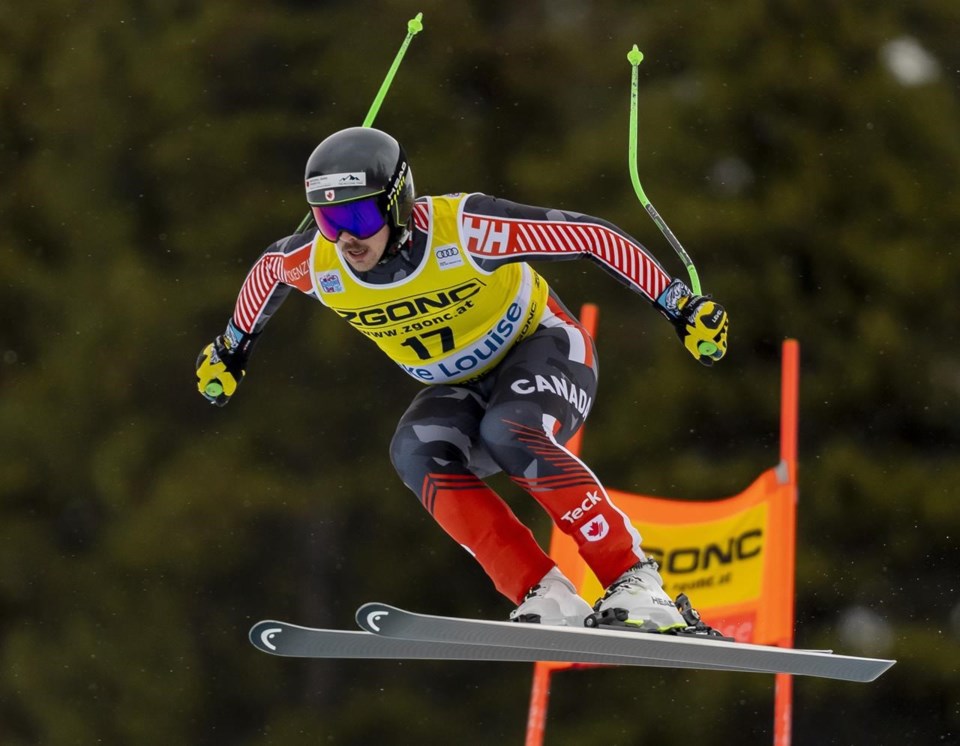If it is the last year of World Cup alpine ski racing in Lake Louise, Alta., after three decades there, Canada's team wants to make it memorable.
The men open the international speed season with Friday's downhill followed by super-G races both Saturday and Sunday at the Banff National Park resort.
"The downhill is the iconic one and it's something I think a lot of people will cherish this year," said Canadian racer James Crawford.
The women arrive next week for a pair of downhills and a super-G on Dec. 2-4.
A young Canadian men's downhill team wants to build on its leap forward of last season, when three athletes reached World Cup podiums for the first time and Toronto's Crawford won an Olympic bronze medal in alpine combined.
Downhill may be the glamour event, but Canadian men's head coach John Kucera says a pair of super-Gs play to the host team's strengths.
"Super-G is these guys' stronger discipline of the two," the coach explained. "It's a super-G that has a lot of different elements.
"You've got to have a bit of a rounded skill set, which I think a lot of these guys bring to the table."
Lake Louise has been a regular stop on the international downhill circuit for over 30 years after the first men's race there in 1980.
It's been a traditional opener of the men's and women's downhill seasons because it's reliably cold enough by the end of November for snowmaking equipment to augment the snow base and build courses.
The introduction of women's giant slalom World Cups in Mont-Tremblant, Que., starting in 2023 on what would be same December weekend as women's downhills in Lake Louise is a strike against the Alberta resort retaining the women's event in the future.
Alpine Canada chief executive officer Therese Brisson has committed to keeping a men's speed World Cup somewhere in Western Canada, so tried and tested Lake Louise must again prove its financial and logistical viability.
The world governing body of skiing and snowboarding attempted to start the downhill season unusually early with a pair of men's races Oct. 29-30 and two women's Nov. 5-6 in Europe.
Weather wiped out all four races, so the season-opener reverted to Lake Louise in late fall.
"If you want to race downhill that early in the world, Lake Louise is almost the only place that's consistent," Kucera said.
"It is really consistent for speed because Europe is really tough at that time of year. Norway is too dark."
Among Lake Louise's challenges is its isolation.
The workforce required to stage the event and groom a three-kilometre mountain course travels from outside the national park, as do the spectators.
Lake Louise doesn't draw the large crowds of European events. The fans around the finish area consist mainly of recreational skiers taking a break from their fun.
Brisson says snowmaking costs there are among the highest in the world, and that two weekends totalling six races are needed to justify the cost.
"I try not to dwell on the fact that this could be the last time, but if I do have to put it into words then I just have to say it would be sad," Crawford said.
"It would be hard for me to say I'm not bummed that it would be my last time racing out of a venue that's been so influential on not just me, but our whole team."
What's been the lone Canadian stop on the alpine downhill circuit is where the majority of Canadians cut their World Cup teeth.
They competed in developmental Nor Am events, got their taste of the big leagues by forerunning World Cup races and made their debuts there.
"It's been a place that's been a huge part of my career." Crawford said. "It's where I scored by first World Cup points. It's the track that got me versed in what World Cup downhill can be like.
"Definitely a huge comfort level. We've run that track more than three times more than any other track."
Cameron Alexander won his first World Cup downhill gold in March in Kvitfjell, Norway after sitting out almost two seasons with a knee injury.
The 25-year-old from North Vancouver, B.C., will not race in Lake Louise. He said recently in an Instagram post he reinjured his knee while dryland training at the end of last season.
Crawford, also 25, followed up his Beijing bronze in combined — the combined time of downhill and slalom runs — by finishing second in Kvitfjell's super-G.
He was the fastest among 82 starters Wednesday in the first downhill training run at Lake Louise. Thursday's training was cancelled.
Broderick Thompson of Whistler, B.C., earned a super-G bronze last December in Beaver Creek, Colo.
Lake Louise hasn't been immune to the alpine racing's climate struggles globally. The men's races in 2016 were cancelled because temperatures were too warm to make snow.
Heavy, wet snow blanketing men's race weekend last year, and straining grooming capabilities, reduced a three-race program to one downhill. Snow is forecast for all three men's race days in Lake Louise.
"Hopefully Mother Nature co-operates and it's all good," Kucera said. "We love racing at home. It's our one race that we get and this year, who knows what's going to happen with Lake Louise in the future?
"It could be extra special because it may be the last race we have there. Hopefully we can put a good show on for the fans."
This report by The Canadian Press was first published Nov. 23, 2022.
Donna Spencer, The Canadian Press



